036
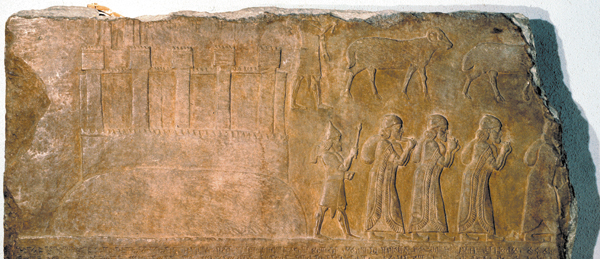
037
The popularly told story of the Israelites’ exile under Assyrian rule is a simple one: The Assyrians conquered the northern kingdom of Israel in 722 B.C.E. and deported the population. These Israelites—the “Ten Lost Tribes”—were never heard from again.
Actually, the situation was more complicated—and more interesting. The demise of the northern kingdom of Israel was a longish affair, lasting from 734 B.C.E. to the conquest of the capital at Samaria in 722 B.C.E. and its reconquest in 720 B.C.E. And, though the deportation of the Israelites began with the early Assyrian campaigns in 734–732 B.C.E., it continued until at least 715 B.C.E.
Furthermore, three different Assyrian kings were responsible for Israelite deportations: Tiglath-pileser III (745–727 B.C.E.), Shalmaneser V (727–722 B.C.E.) and Sargon II (722–705 B.C.E.).
Before 745 B.C.E., Assyria had experienced a period of political weakness. The accession of Tiglath-pileser III, one of Assyria’s greatest military leaders, marked the resurgence of Assyrian power. Israel, by contrast, had seen its territory expand to its greatest size yet under King Jeroboam II (c. 782–753 B.C.E.), resulting in a 038period of considerable prosperity. But after the death of Jeroboam II, internal weaknesses within Israel led to a series of usurpations.

In the approximately three decades from the death of Jeroboam II to the demise of Israel, six different kings ascended the Israelite throne. Jeroboam’s son Zechariah was assassinated after a reign of only six months. His assassin, Shallum, was himself murdered after only a month on the throne. Shallum’s successor, Menahem, ruled Israel for a decade. However, by the end of his reign, Israel had become a voluntary tributary to Assyria. (Tiglath-pileser’s inscriptions list Menahem among the vassal kings in Syria-Palestine.) Menahem’s annual tribute was 1,000 talents of silver, according to 2 Kings 15:9 (in which Tiglath-pileser is referred to as Pul).1 This tribute was enormous and undoubtedly played a part in Israel’s eventual decision to join an anti-Assyrian coalition.
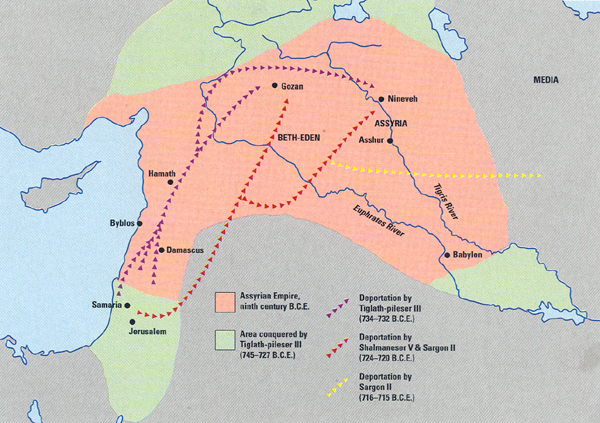
Menahem’s son Pekahiah ruled for two years before he was overthrown in a coup led by Pekah, who then became king. It was Pekah who joined an anti-Assyrian coalition led by Rezin of Damascus. This alliance eventually proved disastrous for Israel. It is unclear whether the Damascus-Israel coalition or Assyria initiated the hostilities that scholars call the Syro-Ephraimite War. If Rezin and Pekah did provoke it, they may have been trying to put pressure on Ahaz, king of Judah, to join their cause. But a cowed Ahaz opted for Assyrian vassalage instead, and the plan (if it was one) backfired in other ways.
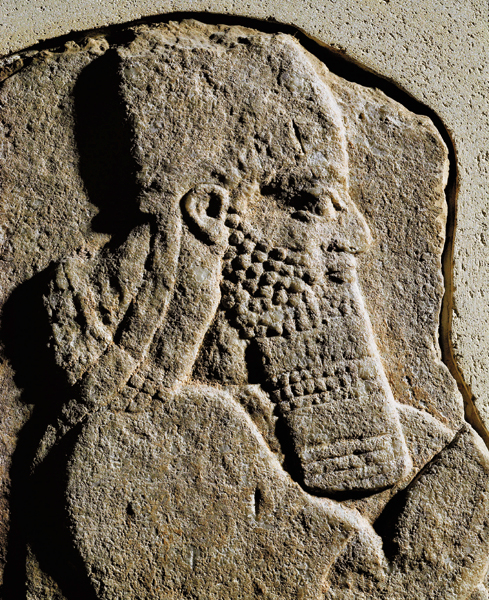
Between 737 and 735 B.C.E. Tiglath-pileser campaigned in Media and Urartu. In 734 B.C.E. he turned his attention westward. First he focused on Philistia and the Israelite coastal region. The conquest of Gaza (and the control of this ancient terminus of the spice trade) seems to have been the major objective of his campaign. Israel probably lost its coastal region during this campaign.
Next, since Rezin was the ringleader of the western coalition, Tiglath-pileser turned to Damascus. Throughout 733 and 732 B.C.E. Damascus was besieged and its environs ravaged. In 732 B.C.E. the city was captured and destroyed; its inhabitants were deported, and Rezin was executed. The entire land of Damascus was annexed to Assyria. Tiglath-pileser’s annals describe the situation:
[…of] Rezin [the Damascene…]. [I captured] heavy [booty] […]…[(With) the blood of his] war[riors] I dyed a reddish hue the river of […], raging [torrent]; […], his courtiers, charioteers and […], their weapons I smashed; and […] their horses I […]. I captured his warriors, archers, shield- and lance-bearers; and I dispersed their battle array. That one (i.e. Rezin), in order to save his life, fled alone; and he entered the gate of his city [like] a mongoose. I impaled alive his chief ministers; and I made his country behold (them). I set up my camp around the city for 45 days; and I confined him like a bird in a cage. His gardens, […] orchards without number I cut down; I did not leave a single one.2
While Damascus underwent this siege, Assyrian troops launched a two-pronged attack into Israel—one 041prong into Transjordanian Gilead and the other into Galilee. Gilead had been the base of Pekah’s political strength. For all practical purposes, this base was now eliminated. Assyria’s conquest of Gilead is reported in the Bible thus:
So the God of Israel stirred the spirit of Pul king of Assyria, even Tiglath-pileser king of Assyria, who deported the Reubenites, the Gadites and the half-tribe of Manasseh [the Transjordanian tribes]. He brought them to Halah, Habor, Hara and the river of Gozan, (where they are) to this day (1 Chronicles 5:26; see also 1 Chronicles 5:6).3
As this passage indicates, the conquest marked the beginning of the deportation of the Israelites to Assyria. Another Biblical passage documents the Assyrian conquest and deportation from Galilee:
In the days of Pekah king of Israel, Tiglath-pileser king of Assyria came and took Iyyon, ’Abel-Beth-Ma’acah, Yanoa
h , Kedesh and Hazor—Gilead and Galilee—all the land of Naphtali; and he deported the people to Assyria (2 Kings 15:29).
“Galilee and Gilead” are almost surely a gloss, added later by a scribe as a geographical update. But the basic documentation is clear.
The deportation from Transjordan has been pictured in Tiglath-pileser’s reliefs from Calah (Nimrud), which depict the deportation from the city of Ashtaroth. Moreover, Assyria’s victory in Transjordan is mentioned in a fragmentary Assyrian inscription, which also refers to the deportation of Israelites:
I carried off [to] Assyria the land of B
éµ t-Hå umria (Beth Omri or Israel), […its] ‘auxiliary [army,’] […] all of its people.4
This same text records the overthrow of Pekah and the installation of his successor Hoshea:
[I/they killed] Pekah, their king, and I installed Hoshea [as king] over them. I received from them 10 talents of gold, x talents of silver…
The Biblical text is consistent with this: “Hoshea son of Elah conspired against Pekah son of Remaliah, attacked him, and killed him. He succeeded him as king” (2 Kings 15:30). Hoshea was a vassal to the Assyrian ruler and paid tribute to him. Later, when Shalmaneser V was king of Assyria, Hoshea withheld his tribute, and was deposed (2 Kings 17:3–4). Hoshea was the last king of the northern kingdom of Israel.
Tiglath-pileser’s victory in Galilee is documented in a number of Assyrian accounts. Two of these are fragmentary, but nearly identical in the content that survives. Putting them together we learn that Tiglath-pileser “leveled 16 districts of B
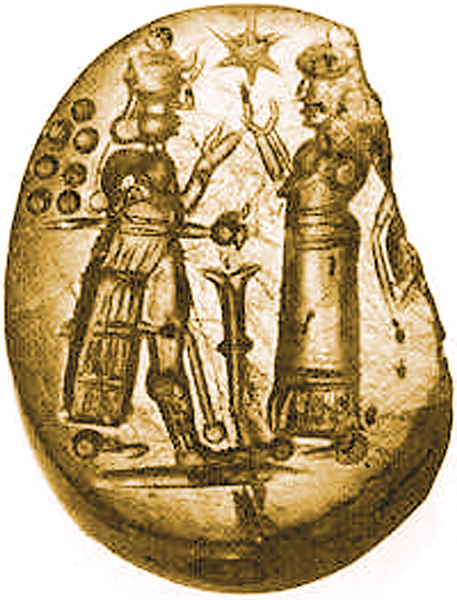
Accordingly, Israeli archaeologist Zvi Gal’s survey of Lower Galilee demonstrates a marked decline in the settlement of the region at the end of the eighth century B.C.E., a decline that continued through the sixth century.6 Gal has found that the population of Lower Galilee when Tiglath-pileser invaded was approximately 17,600. Taking into account those Israelites killed in the invasion as well as the 13,520 documented deportees, the Israelite population in the area was virtually obliterated. And major Israelite sites in northern Israel, like Hazor, Kinneret and Megiddo, show clear evidence of Assyrian destruction from this period.
Though the Assyrians typically utilized a bi-directional deportation policy, in this case the archaeological evidence of destruction clearly indicates that Tiglath-pileser’s deportations were uni-directional. He did not settle other peoples in Galilee. Just 30 years later, in 701 B.C.E., the Assyrian king Sennacherib implemented another uni-directional deportation of thousands of Judahites.
Tiglath-pileser III died in 727 B.C.E., but Assyria was not through with Israel. Tiglath-pileser’s successor, Shalmaneser V, ruled for only five years, until 722 B.C.E. This gave him enough time, however, to attack Shechem and besiege (and apparently capture) Samaria (see 2 Kings 18:11). In the well-preserved destruction layer of stratum VII at Shechem, excavators found an Assyrian seal amid the debris. It pictures the warrior goddess Ishtar standing in front of a worshiper, a sword at her side. G. Ernest Wright, the chief excavator, dated the destruction of Shechem to 724 B.C.E.—the time of Shalmaneser V’s reign—on the basis of this seal.7 Shalmaneser’s campaigns probably also resulted in some deportations of Israelites, although no records of these have survived.
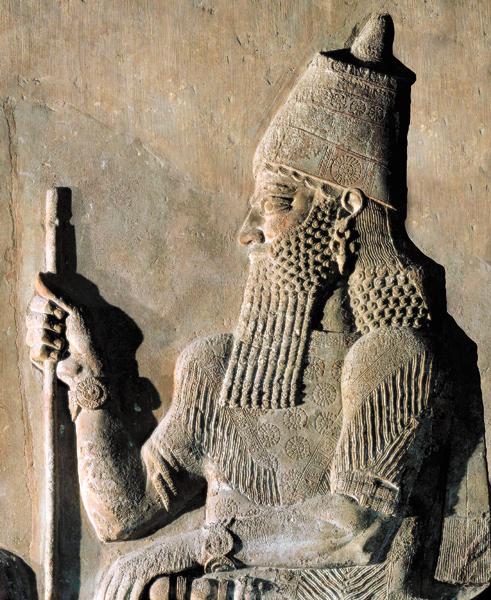
According to Mesopotamian and Biblical sources, 042Shalmaneser V conquered Samaria in 722 B.C.E., but he died a natural death in the last months of that year. After an internal struggle, Sargon II came to the Assyrian throne and soon faced a rebellion in Syria-Palestine. In 720 B.C.E., Yau-bi’di of Hamath organized a western coalition—including Samaria—to challenge Sargon. But Sargon defeated this coalition decisively at the battle of Qarqar (the very site where Shalmaneser III had fought a western alliance in 853 B.C.E.). Yau-bi’di was flayed alive in public. The scene is even depicted in ghastly detail on one of Sargon’s commemorative reliefs. Soon after this battle, Sargon besieged and recaptured Samaria.
In his so-called Great Summary Inscription, Sargon flatly states:
I besieged and [re]conquered Samarina (the Assyrian spelling of Hebrew Shomr
oµ n, i.e. Samaria). I took as booty 27,290 people who lived there. I gathered 50 chariots from them. I taught the rest (of the deportees) their skills. I set my eunuch over them, and I imposed upon them the (same) tribute as the previous king (i.e., Shalmaneser V).8
The Nimrud Prism, also commemorating Sargon’s rule, reads similarly. After boasting of how he deported and resettled Israelites in “the midst of Assyria,” Sargon claims that “I repopulated Samerina more than before. I brought into it people from countries conquered by my hands. I appointed my eunuch as governor over them. And I counted them as Assyrians.”9
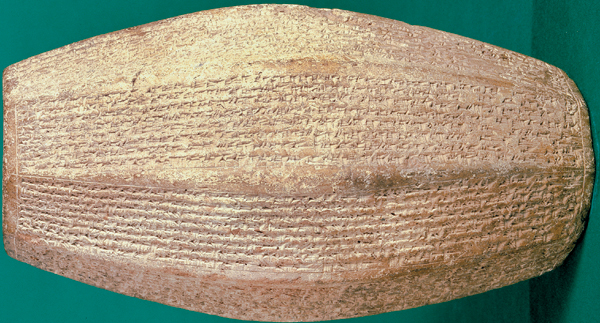
Following this re-conquest in 720 B.C.E., Sargon deported, as noted, 27,290 people. In 716 B.C.E., the king captured Median territory, an event that probably occasioned another deportation of Israelites to the “cities of the Medes.” Sargon’s deportations were bi-directional: He explicitly claims to have repopulated Samaria with deportees from other nations.
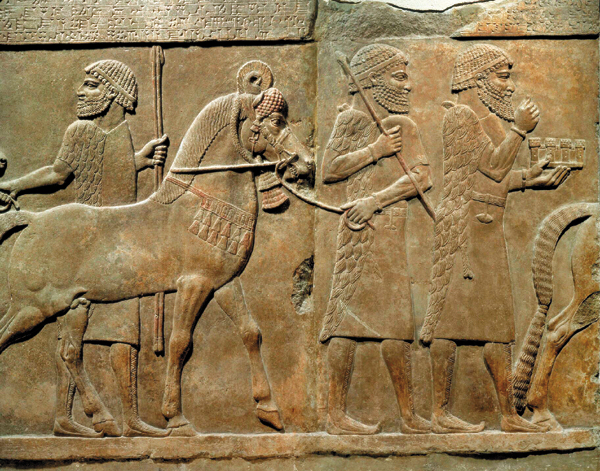
Staggered deportations of Israelites, therefore, occurred from about 734 B.C.E. to 716 B.C.E.
045
We have an enormous amount of information about the life of the Israelites in this enforced diaspora—at least relatively speaking. Some deportees seem to have been treated very well; most were treated terribly. A person’s fate depended on his prior status and skills, and especially on how well those skills matched the needs of the Assyrian administration.
Such large-scale deportations must have required extensive administrative personnel. No doubt the Assyrian administration was well-organized and capable of directing and controlling the peripheral regions of the empire. Palace reliefs depict Assyrian scribes interrogating captives for information that could be useful as propaganda against the king’s enemies. Often two scribes are pictured: one writing, the other interrogating deportees.
Assyrian records reveal that Israelite deportees served as military personnel, officials, priests, skilled laborers and merchants. Israelites in these roles were treated as Assyrian subjects. The phrase “I counted them as Assyrians,” which appears at the end of the passage quoted above, was used as early as the time of Tiglath-pileser I (not III), that is, 1114–1076 B.C.E.
Many deportees relieved native Assyrians of their domestic duties so they could serve in the military. Furthermore, evidence from personal names shows that at least one-fifth of Sargon’s army was West Semitic (an ethnic group that included, but was not limited to, Israelites). An entire unit of Tiglath-pileser’s army was comprised solely of deportees, professional soldiers from various Levantine states. This unit had its own commander, known as the “commander of deportees.” Israelites almost surely served in this unit. Later, according to Assyrian administrative texts, Sargon added an entire unit of “Samarian” charioteers to his army.10
A key element for detecting Israelite names in Assyria is the suffix “-Yau.” Scholars call this a theophoric element, a divine component in the name. The particular theophoric element here is a form of Yahweh, the name of the Israelite God. Many names with the “-Yau” suffix appear in Assyrian military records, denoting a person’s Israelite identity. For example, a certain Nadbi-Yau from Nineveh was a chariot driver 065during the reign of Sargon II. In a contract dated 709 B.C.E., he acts as a witness for the royal charioteer
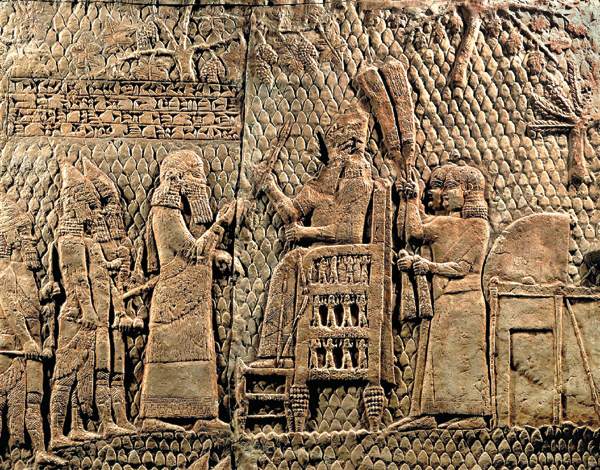
Literate deportees were integrated into the imperial administration. Some even attained high office. A deportee from Samaria named Sama’ was elevated at the Assyrian court to the role of “commander of teams” of horsemen. If he is the person with the same name who is mentioned in economic and administrative texts from Balawat and Nineveh, then he was a person of great influence within the family of Sargon and Sennacherib.
Another example of a high-ranking Assyrian official with possible Israelite origins is the famous rab sh
Two Israelites are listed in the Assyrian administration of Esarhaddon (680–669 B.C.E.), Sennacherib’s son. One, Ne
One of the locations to which Israelites were deported, according to the Bible, was Halah, which may be identified as the province of
[Concerning what the king], my lo[rd], wrote to me: “Provide the [Sam]arians [as many as] are [in] your [ha]nds (with work) in D
uµ r-Sð arrukin,” I thereafter [sent (word) to] the sheikhs [say]ing: “gather [all] the carpenters and potters; let them come (and) [direc]t the deportees [who are in D]uµ r-Sð arrukin.”11
During the reign of Ashurbanipal (668–627 B.C.E.) an Israelite named Iad
Surprisingly, Israelites served as Assyrian priests; a surviving wine list specifies the wine to be allotted to three Samarian 066lamentation-priests. On the other hand, according to the tradition recounted in 2 Kings 17:24–41, a deported Israelite priest returned to Samaria to instruct the non-native peoples who had since settled there in the worship of Yahweh.
We also learn about Israelites in Assyria from contracts and deeds. Occasionally, Israelites are named as parties; more often, they are witnesses. We have more than 20 legal documents in which Israelites served as witnesses. In some of these cases, interestingly enough, the parties are Assyrian. But we must be careful not to be fooled by an Assyrian name. A process of “Assyrianization” can be detected working along generational lines: A father bears an Israelite name, his son an Assyrian one. For example, in a contract from 631 B.C.E. a certain Halmusu, who identifies himself as the son of A
In a contract from the Habur River region that dates to 602 B.C.E., Adad-milki-
So far we have been talking about the lucky ones. Most Israelite deportees lived under an ideology of terror. Only a few received preferred or even considerate treatment. The vast majority endured a bare subsistence with many hardships. A fragmentary list of the rations that were provided to the forced laborers at D
The Assyrian army was paid partly in rape and plunder of the enemy’s land, activities that they indulged in even before the deportees had embarked on their long trek. Being uprooted from one’s home and forcibly moved a great distance surely resulted in emotional shock, such as the Book of Lamentations describes with reference to the Babylonian deportation from Judah that took place a century later. Doubtless the same description would also apply to the exiles in Assyria.
Yet these were not death marches. Assyrians were concerned that the deportees arrive at their destinations healthy enough to work. In one letter, a high official named A
In another letter, the king commands an official, A
Seven times over you shall not be careless; for that you would die. If there is anyone sick among the captives whom they bring to you, you shall gather (them) together from among (the group). However many there are, they shall transport (them), (and) place them in your presence until they are fit.
Assyrian records confirm that the Israelites were taken to the same locations that the Bible identifies—Halah (the Assyrian province of
No extra-Biblical evidence confirms the settlement of Israelites in the cities of the Medes, probably because that region has not yielded as much archaeological evidence as Assyria proper. But this settlement almost surely did take place. Judging from the names on an ostracon found at Tell Jemmeh in Israel, we know that Medians were deported to the southern Levant, so we would hardly be surprised to find Israelites deported to the land of the Medes.
That some Israelites were slaves is the clear implication of a text dated to 700 B.C.E. in which an Israelite named Mannu-k
The only Israelite women mentioned in the Assyrian records were slaves. In a text dated to 680 B.C.E., a man named Use’a (Hosea) and his two wives, B
Life for most Israelites deported to Assyria, we can conclude, was “poor, nasty, brutish and short.” Probably the bulk of the Israelite deportees served as agricultural laborers organized into “cohorts,” which were modeled along military lines. The cohorts were probably assigned to farmland owned by high state officials, by the Assyrian temples or by the king himself. Agriculture was the heart of the Assyrian economy. In order to maximize farming productivity, the state forced the deportees into a socio-economic mold that promoted their assimilation—their Assyrianization.
Not only can we account for the various deportations of the Israelites that took place in the period 734–715 B.C.E., but we can also trace the process of their assimilation into Assyrian culture. In this sense, the Israelites were never “lost.” Though the legend of “the Lost Tribes” continues to capture people’s imaginations, archaeology has made it possible for us to understand what actually happened to this ancient diaspora.
The popularly told story of the Israelites’ exile under Assyrian rule is a simple one: The Assyrians conquered the northern kingdom of Israel in 722 B.C.E. and deported the population. These Israelites—the “Ten Lost Tribes”—were never heard from again. Actually, the situation was more complicated—and more interesting. The demise of the northern kingdom of Israel was a longish affair, lasting from 734 B.C.E. to the conquest of the capital at Samaria in 722 B.C.E. and its reconquest in 720 B.C.E. And, though the deportation of the Israelites began with the early Assyrian campaigns in 734–732 B.C.E., it continued […]
You have already read your free article for this month. Please join the BAS Library or become an All Access member of BAS to gain full access to this article and so much more.
Already a library member? Log in here.
Institution user? Log in with your IP address or Username
Endnotes
That the names Tiglath-pileser (Tukulti-apil-E
William W. Hallo and K. Lawson Younger, Jr., eds., Context of Scripture (Leiden: Brill, 1997–2002), vol. 2, p. 286.
Since these passages are late, a question has been raised as to how reliable they are. See H.G.M. Williamson, 1 and 2 Chronicles (Grand Rapids, MI: Eerdmans, 1982), p. 67.
Summary Inscription 4:6’-8a’, 15’b-19’a, in Hallo and Younger, Context of Scripture, vol. 2, p. 288.
Zvi Gal, Lower Galilee During the Iron Age, trans. M. R. Josephy (Winona Lake, IN: Eisenbrauns, 1992), p. 109.
William G. Dever, “Excavations at Shechem and Mt. Gerizim,” Eretz Shomron. The Thirtieth Archaeological Convention, September, 1972 (Jerusalem: Israel Exploration Society, 1973), pp. 8–9 (Hebrew).
